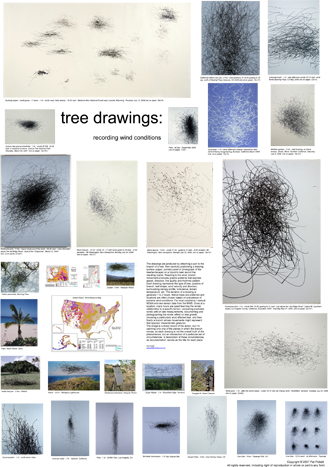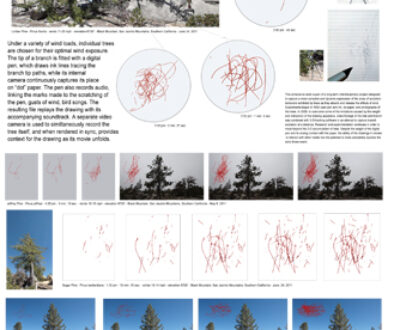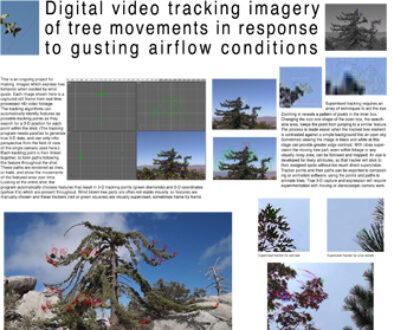International Conference on Wind and Trees IUFRO August 5-9, 2007, University of British Columbia, Vancouver, BC
International Conference on Wind and Trees IUFRO August 5-9, 2007
University of British Columbia, Vancouver, BC
Tree Drawings: Recording Wind Conditions
P. Pickett
The following describes a devised method of capturing “drawings” of the movement of branches under a wide variety of airflow circumstances. This graphic model is produced by attaching a pen to the lower branch of a tree and, on a tripod, carefully positioning a drawing surface to best record the resulting marks. Reacting to the wind, branch movement produces patterns that are characteristic of the type of tree, position of branch, leaf shape, wind velocity and direction, surrounding canopy profile, turbulence, terrain, temperature, etc. (Tree identification was taught to me by father, who studied forestry at Oregon State University.) In early experiments, beginning in 1999, designed to make visual models of (usually) invisible forces, I used a convenient backyard pear tree at the Dan Flavin Art Institute, on eastern Long island, in order to record the winds’ effect on trees.
Currently native trees are preferred and locations are chosen based on the prevalence of extreme wind conditions (Paloverde in the Banning Pass, California; kiawe at Makapuu, Hawaii; a grove of aspen near Laramie, Wyoming; krummholtzed (dwarfed) black spruce on Mt. Washington, New Hampshire.) As a general guide I use the NREL wind resource maps. For local conditions I consult NOAA and raw sensor data from the NWS. Once at a location, many hours are spent observing the winds’ relationship to the specific terrain, comparing the predicted wind-speeds with on-site measurements using a Kestrel 4000 anemometer, documenting and photographing examples of thigmomorphogenesis (winds’ effect on tree growth). I then choose a particularly wind affected tree, and a branch whose movements are a good representative of that species characteristic gestures. The duration of a drawing is anywhere from ½ hour to 5 hours. The title of each drawing includes documentation of the conditions (eg, Knobcone pine – 1 hr – winds NW 12-28, gusting to 31 mph – just above the “Old Ridge Route”, Leibre Mtn., Elevation 4500’, Southern California, Sat. May 27, 2007.)



